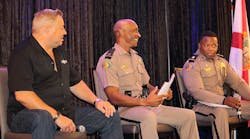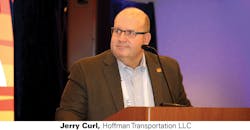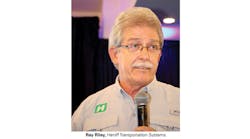IGNORANCE is an excuse, but it’s not likely to garner much sympathy from a trooper conducting a roadside inspection.
Catch them in a classroom, however, and they’re more likely to feel charitable.
The Florida Highway Patrol’s Maj William Harris, the Troop J Commander who oversees commercial vehicle enforcement operations for Florida’s southern region, and Lt Steven Brown certainly were willing to share tips and tales gleaned from their experiences with electronic logging devices (ELDs), and the drivers who are (trying) to use them, in the session “ELD Mandate: Personal Conveyance in the Tank Segment,” during NTTC’s 2019 Safety & Security Council Meeting.
“Drivers really need to get educated on the device they have,” Harris said.
The troopers were joined by Fred Fakkema, a retired Washington State Patrol trooper who’s vice president of compliance for Zonar Systems—which provides fleet management technology, including ELD devices—and moderator Jerry Curl, director of operations for Hoffman Transportation.
They highlighted key differences between older Automatic On-Board Recording Devices (AOBRDs) and ELDs, which ensure drivers remain compliant with Federal Motor Carrier Safety Administration (FMCSA) Hours of Service requirements—data transfer is the biggest—and discussed Personal Conveyance rules before fielding questions from concerned carriers and other attendees.
“Drivers better know which (device) they’re using when they get stopped roadside, because there are big differences,” Fakkema said.
Data transfer
Per FMCSA regulations, ELD devices must be able to transfer data wirelessly, through a telematics system or other web service, or locally, through a USB 2.0 or Bluetooth connection, to an authorized safety official to ensure law enforcement can review HOS data during a roadside inspection.
AOBRDs came with no such requirements, and many companies still are adjusting.
Other differences include new graphical displays, and handling new issues, like malfunctions and unidentified driving events.
Harris said, overall, ELDs make their job easier and get truckers back on the road and making money more quickly, primarily through their ability to transmit HOS data directly to an inspector’s eRODS (electronic record of duty status) system, but the system isn’t without its difficulties.
When problems with data transfer arise, Harris said email works fine.
“That’s what we find works better, really, because, with the new technology, especially the eRODS, (the data is) getting fragmented a little bit, and sometimes it doesn’t show everything,” he said.
But many times it’s simply user error.
“The two biggest things that we’re hearing from roadside inspectors are personal conveyance is being over-utilized—and it shouldn’t be—and the next is not understanding how to operate the ELD, and not having your instruction sheet, or cab card as it used to be known, on hand,” Fakkema said.
Personal Conveyance
Truck drivers aren’t always politically correct, but they do need to understand PC nuance, as FMCSA sees it anyway.
By definition, personal conveyance is the movement of a commercial motor vehicle for personal use while off duty. But clearly it’s more confounding than that for many carriers still struggling to apply the rule to every situation, including various “yard moves” and trouble finding parking.
That’s why Fakkema recommends companies put PC rules to paper.
“You really have to have a policy for PC, and probably bigger than that is, you have to follow your policy,” he said. “So if you have one, make sure you enforce it, and make sure you set those parameters for your drivers.”
Fakkema recommended setting mileage and/or time parameters, and staying informed about what drivers are doing, and what their ELDS are capable of, because system features vary vendor to vendor.
“You have to know when you can use PC,” Brown said. “That’s the biggest issue.”
He emphasized return trips aren’t personal time. A vacation after finishing a run is personal conveyance, as long as it’s strictly for personal activity that doesn’t advance the operator’s business.
“I always say don’t do the what-ifs,” Brown said. “Get yourself inside that box and stay there because when you start to do a lot of what-ifs, that’s when you get in trouble. Now you have a false log because you’re claiming something you’re not allowed to do, and that’s going to get you jammed up every time.”
Troubleshooting
Does law enforcement interpret PC rules the same across the country, or do interpretations vary by state?
Harris said he can only speak for Florida, and admitted different agencies can interpret regulations differently. Troopers attend CVSA conferences across the country, trying to get on board with other states so all HOS rules are universally enforced, but that’s easier said than accomplished.
In the meantime, it’s a good idea for carriers to develop a relationship with their local enforcement agency.
“If you know the enforcement agency in your area, let them see your policy, and say ‘How would you enforce this?’ so everybody can be on the same page,” Harris said. “We really want to be on the same page with enforcement and interpretation.”
If there’s any doubt about the process, roadside is not the place to sort it out.
Harris said troopers’ primary objective is to educate and make the road safer, not find violations, so they’ll always err on the side of safety, and cite drivers deemed out of compliance. But troopers can make mistakes, so his office is willing to review violations, and overturn them when warranted.
Can drivers use their PC to move to a better parking spot, or would that disrupt their 10-hour break and put them in violation?
“We have been enforcing that as allowing them to use personal conveyance to move to that safe location,” Harris said. “I can’t speak for other states … but moving to a safer location is fine in Florida.”
The key is to educate the driver, he said, and make sure they have a valid explanation for a trooper conducting an interview.
Fakkema advised logging any movement that could be questioned.
“I always say annotate, annotate, annotate, because it lets roadside know what happened,” Fakkema said. “The driver may not remember four days later what exactly happened, but if a driver puts an annotation in there, it makes it a lot simpler.”
In the case of a malfunction, when the driver must move to a paper log, what constitutes as written notification to the carrier?
Harris said Florida troopers only are looking for notification, not delivery method, so any documented form will do, hand-written, faxed, emailed, texted or otherwise. But notice must be given within 24 hours, and the driver must have eight days of paper logs available for roadside inspection.
“You have to notify the carrier, because within eight days, that thing needs to be repaired,” Brown said.
Is there any tolerance for a driver who exceeds his 11-hour drive time by 1 minute?
The troopers didn’t have an exact answer, but Fakkema said it’s probably discretionary in most states. And while drivers can be cited for 1 minute over, CSA points are mitigated for minor overages.
“It’s going to be the decision of the inspector, whether they’re going to write it down or not,” he said. “That’s how it is at roadside.”
If a carrier can’t immediately deliver a paper log to the driver, will an electronic version suffice?
Brown said he will accept an electronic copy, such as a pdf version, delivered to a driver’s device. Harris said they recently had a situation where an ELD malfunctioned, and the driver was able to contact the carrier and have logs emailed promptly to the trooper, who accepted them, but again, if neither the driver nor the carrier can supply the data roadside, they will place the driver out of service.
Do yard moves count as personal conveyance?
A yard move is any on-duty movement in an area closed to the public, so if carriers are moving vehicles around a “yard,” note yard movement on the ELD. However, unlike with AOBRDs, automatic changes aren’t made with ELDs in most circumstances. Exceptions are when drivers start driving, or when they’ve stopped for longer than 5 minutes, and automatically enter on-duty, not driving.
“The newest one now is, when they’re in the yard move, and they get up to 20 mph, we can put them into drive, or when they exit the yard we can put them into drive,” Fakkema said.
It’s a good idea to establish yards in the ELD, he said, especially when vehicles are moving around a lot for cleaning or maintenance, and then those moves can be dropped into a yard “bucket” on the back end so the mechanic or person who’s doing the washing doesn’t have to log onto the device.
If a truck exits through one gate and enters through another to access a different part of the facility, the move can be considered a yard move, Fakkema said. If mechanics are running trucks to a nearby shop, those can be yard moves, or mechanics can be classified as exempt if they stay within 100 air-miles.
What if a driver accidently sets unassigned movements?
Fakkema said guidance for unidentified drivers recently changed. Previously, if a vehicle started moving without someone logged into the ELD, and an unknown driver event was created, it couldn’t be corrected.
“Anything on the driveline, you could not change at all, so the driver would be prompted, ‘Hey, there’s an unidentified driving event that took place. Is this yours?’ Well, most drivers, when they see a prompt, they just say yes, so then it’s assigned to their drive time and it screws up their hours,” Fakkema said. “And then as a vendor, we couldn’t change that because it’s on the driveline.
“So that was recently changed by FMCSA to say that, if it was erroneously accepted, you can change it, but it has to be assigned to the appropriate driver.”













